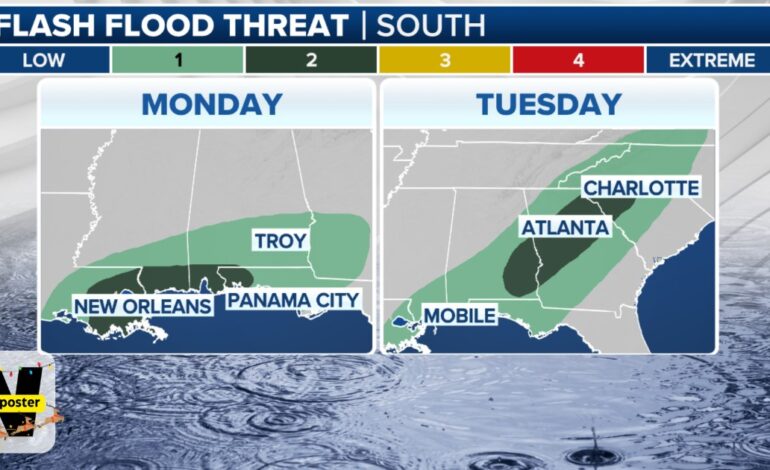
Heavy Rainfall and Flood Risk Escalate Across Deep South, New Orleans and Mobile Brace for Impact: Extended Storm System to Deliver Dangerous Conditions and Severe Weather Threats
Heavy Rainfall and Flood Risk Escalate Across Deep South, New Orleans and Mobile Brace for Impact: Extended Storm System to Deliver Dangerous Conditions and Severe Weather Threats
In a rapidly developing weather scenario, the Deep South is bracing for widespread and significant rainfall, with flash flood risks escalating as a potent weather system moves through the region. Both New Orleans, Louisiana, and Mobile, Alabama, are among the cities facing a significant threat as heavy rain begins to fall on Monday, with conditions set to worsen on Tuesday. The National Weather Service has issued warnings and advisories for much of southeast Louisiana and southern Mississippi, highlighting the growing flood risks for these areas. This storm system could also impact surrounding regions, including Georgia, Texas, and parts of the entire East Coast as the week progresses.
Heavy Rainfall Predicted to Bring Flooding Risks to New Orleans and Mobile
The approaching storm is expected to bring widespread, heavy rain to much of the Deep South, creating ideal conditions for flooding. Forecasts predict that some locations could receive over three inches of rain by Wednesday, with localized totals possibly exceeding five inches, which would significantly increase flood risks in areas like New Orleans and Mobile.
The sudden deluge of water, after a prolonged dry period, could cause rivers, streams, and drainage systems to become overwhelmed. Low-lying areas and those with poor drainage infrastructure, particularly in urban settings like New Orleans, are most at risk of inundation.
The storm system’s development has been characterized by a weak area of low pressure forming in the northern Gulf Coast. As this weather feature strengthens and organizes, it will continue to concentrate the heaviest rainfall in areas like Louisiana and southern Alabama. A warm front along the Gulf Coast is exacerbating the precipitation, with moisture feeding into the atmosphere from the Gulf of Mexico. Meteorologists have expressed concerns about the potential for flash flooding as the storm intensifies.
The city of New Orleans, which has seen its share of flood events due to its below-sea-level elevation and aging infrastructure, is particularly vulnerable. In addition, Mobile, with its coastal location and propensity for sudden weather changes, is also preparing for serious flooding risks. Emergency teams in both cities are on high alert, ready to respond to any weather-related emergencies.
Alleviating Drought Conditions and the Trade-Off of Increased Flood Risk
While this storm is causing serious flooding concerns, there is a silver lining in that the rain will help alleviate drought conditions in the region. Over the past several months, parts of Louisiana, Mississippi, and Alabama have been experiencing drought conditions that have impacted agriculture, water supplies, and the overall health of the region’s ecosystems. However, the trade-off for this much-needed rain is the severe flood threat it carries, particularly in already saturated areas.
The National Weather Service issued a Flood Watch that will remain in effect until Tuesday morning for southeast Louisiana and southern Mississippi. The alert is a warning that river and street flooding may occur as a result of the heavy rainfall, particularly as the ground is already dry and less able to absorb large amounts of water.
Though this rain is a positive development for alleviating drought conditions, the immediate concerns for urban areas are substantial, with authorities worried about widespread damage to infrastructure and the safety of residents. Flooded roadways, downed trees, and hazardous driving conditions will all become serious concerns in the coming days as the weather system intensifies.
Cold Front to Follow, Raising the Flash Flood Risk Across the Region
As the storm system continues to intensify, a powerful cold front is expected to push through the Deep South, drawing even more moisture from the Gulf of Mexico. This will increase the flash flood threat, not only in New Orleans and Mobile but in surrounding areas, including parts of Georgia and Florida, before it reaches the entire East Coast. This cold front could significantly increase rainfall rates and the likelihood of severe weather in the affected areas.
Flash floods are among the most dangerous weather events because they can develop with little to no warning. As this front moves in, cities like Atlanta could face rapid rainfall, flash floods, and severe weather threats like damaging winds and the possibility of tornadoes. The cold front’s arrival, which will cause sharp changes in atmospheric pressure, also increases the risk of thunderstorms, with the potential for severe conditions.
Meteorologists are closely monitoring the storm system, which is predicted to bring torrential rains and the potential for severe thunderstorms on Tuesday. These thunderstorms could develop rapidly, fueled by the warm, moist air in place ahead of the cold front. Areas such as Texas, Louisiana, Alabama, and Georgia are expected to see widespread rainfall totals of 2-3 inches, but localized areas could receive up to five inches, further exacerbating flood concerns.
Severe Storms and Tornado Threats to Accompany Cold Front
The cold front, which will follow in the wake of the warm front, could also set the stage for severe thunderstorms. As the storm system clashes with the warm, moist air, conditions will be ripe for producing dangerous weather, including severe winds, hail, and potentially tornadoes. The tornado threat is expected to be concentrated in areas where the cold front’s dry air meets the moist, unstable air from the Gulf.
Cities like Mobile and New Orleans are at risk of witnessing strong, damaging winds as the front advances. Strong winds could down trees, power lines, and damage buildings, while torrential rainfall will exacerbate the risk of flash flooding. The possibility of tornadoes is particularly concerning, as they can form quickly and cause widespread devastation.
The National Weather Service has urged residents across the affected areas to be prepared for the possibility of severe storms, including taking steps to secure property and plan for evacuations if necessary. They also advised residents to stay informed through local news and emergency alerts, particularly on Tuesday when the flash flood and severe weather risk will be at its peak.
A Community on High Alert as Recovery Efforts Ramp Up
As New Orleans and Mobile brace for the storm’s impact, local emergency response teams have begun to implement their contingency plans. In New Orleans, efforts are being made to inspect and reinforce flood barriers and levees, which are vital to protecting the city from flooding. Local authorities are also focusing on evacuating vulnerable populations, particularly those in flood-prone areas or without access to reliable transportation.
Meanwhile, in Mobile, public works crews have been clearing storm drains and securing vulnerable infrastructure to prevent the flooding of key roadways. As the storm nears, both cities are urging residents to be prepared to shelter in place and avoid unnecessary travel during the heaviest rain and strongest winds.
Conclusion: A Growing Storm Threat
The Deep South is in the early stages of what could be a very dangerous and disruptive weather event. New Orleans and Mobile, along with other cities in the region, will be heavily impacted by the rainfall, with rising flood risks and the potential for severe weather events. Residents are urged to stay informed, heed all weather warnings, and take steps to ensure their safety as the storm system intensifies.
Meteorologists are closely watching the situation, and emergency responders are on standby, ready to help those affected. As the storm progresses, there will likely be more updates, including flood warnings, severe weather advisories, and possibly evacuation orders for some areas. All in all, while this storm system provides much-needed rain for drought relief, it also brings significant dangers, including flooding, damaging winds, and the threat of tornadoes across the Southeast and East Coast of the United States.



